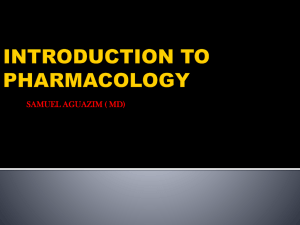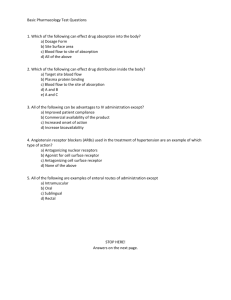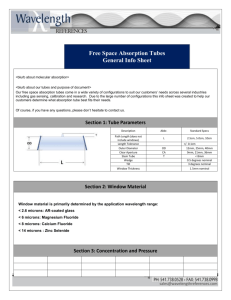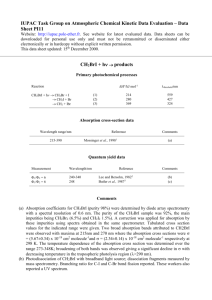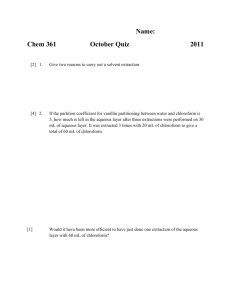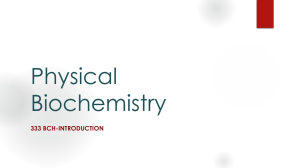1 - Physical Pharmacy Laboratory
advertisement
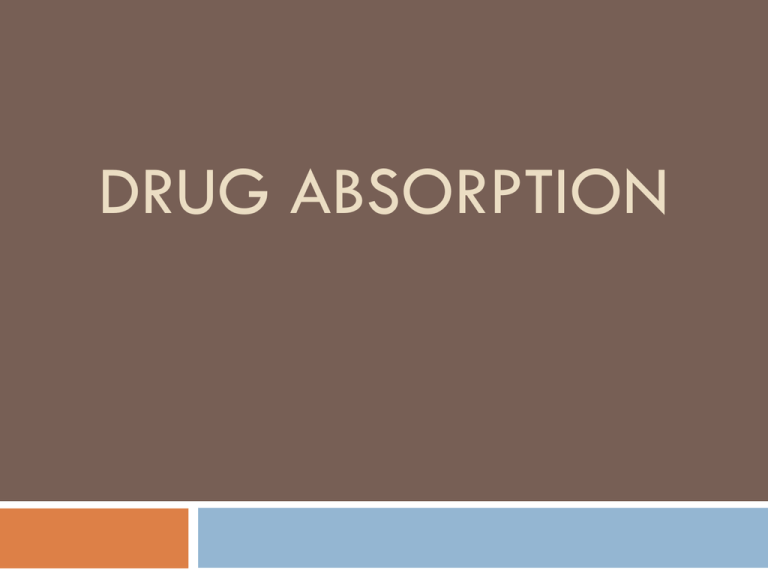
DRUG ABSORPTION Overview 1. The structure and function of biological membranes and the factors influencing the transport of drugs though them 2. The special features of routes for drug administration - oral route and oral absorption - buccal and sublingual absorption - intramuscular and subcutaneous injection - transdermal delivery - eye and ear - vaginal absorption - lung and respiratory tract - nasal and rectal routes - intrathecal drug administration Biological membranes and drug transport Biological membranes 1. Function - to contain the aqueous contents of cells and separate them from an aqueous exterior phase 2. Nature - lipoidal - selectively permeable 3. Structure - composed of bilayers of phospholipids and cholesterol or related structures - embodied hydrophbic proteins in the matrix of lipid molecules - exterior: hydrophilic, negatively charged interior: hydrophobic Biological membranes and drug transport 3. Structure - Cholesterol - major component of most mammalian biological membranes - to fit closely in bilayers with the hydrocarbon chains of unsaturated fatty acids - remove of cholesterol causes the membrane to lose its structural integrity and to become highly - complexes with phospholipids and reduces the permeability of phospholipid membranes Biological membranes and drug transport 3. Structure : fluid mosaic model Biological membranes and drug transport 4. Drug absorption through biological membrane - controlled by the nature of membrane ( its degree of internal bonding and rigidity, Its surface charge) and by physicochemical properties of drugs - passive diffusion : lipid-soluble drugs - transport system : water-soluble drugs Biological membranes and drug transport Lipophilicity and absorption Log P : partition coefficient ratio of the concentrations of the un-ionized solute in solvents used to calculate lipophilic efficiency ex) Log P organic acqueous Dissolution solvent 1 10 1 hydrophobic 0 1 1 both -1 1 10 hydrophilic Organic Acqueous Biological membranes and drug transport Lipophilicity and absorption Drug with high log P values - protein bound - low aqueous solubility - bind extraneous sites Drug with low log P values - too hydrophilic - have any affinity for the membrane - poorly absorbed Typical activity – log P plot Biological membranes and drug transport Molecular weight and drug absorption - The larger MW drug: poorer absorption - A rule of five by Lipinski good oral adsorption is when: the drug molecules has fewer than 5 hydrogen bond donor ( -OH or –NH groups) the molecular weight is less than 500 log P of the drug is less than 5 there are fewer than 10 H-bond acceptor Biological membranes and drug transport Permeability and the pH-partition hypothesis - Assumption only unionised form (U) of drug can pass through membranes by diffusion and ionsied forms (I) will be rejected - Calculation of percentage inoisation weakly acidic drug weakly basic drug Biological membranes and drug transport Discrepabcies between expected and observed absorption Explanations - Absorption and ionisation are dynamic process - The difference between the bulk pH and actual pH Biological membranes and drug transport Problems in the quantitative application ot the pH-partition hypothesis 1. Viability in pH condition - variation in the stomach pH (1-3 vs upto 7): variable dissolution rate of drug - variation in the small intestine by its pathological stauts Biological membranes and drug transport Problems in the quantitative application ot the pH-partition hypothesis 2. pH at a membrane surfaces - pH at the membrane surfaces is lower than that of the bulk pH due to higher hydrogen concentration at the surface the solubility of drug will be changed in the vicinity of the membrane - the secretion of acidic and basic substances in the gut wall Biological membranes and drug transport Problems in the quantitative application ot the pH-partition hypothesis 3. Convective water flow - factors that can make water movement : difference in osmotic pressure between blood and the contents of the lumen difference in hydrostatic pressure between lumen and perivascular tissue - The movement of water molecules affects the rate of absorption of small molecules - if the drug and water are using same route, absorption of water-soluble drug will be increased. Biological membranes and drug transport Problems in the quantitative application ot the pH-partition hypothesis 4. Unstirred water layers - lies adjacent to all biological membranes - additional barrier for absorption of drug Biological membranes and drug transport Problems in the quantitative application ot the pH-partition hypothesis 5. Effects of the drug - the drug must be in its molecular form before absorption - basic drugs are expected to be more soluble than acidic drug in stomach Biological membranes and drug transport Problems in the quantitative application ot the pH-partition hypothesis 6. Other complication factors - the very high area of the surface of the small intestine - co-administration of drugs - drugs are unstable in the gastrointestinal tract metabolised on their passage through the gut wall hydrolysed in the stomach to active form (prodrug) bound to mucin to form complexes with bile salts in charged form Routes of Administration The special features of routes for drug administration - oral route and oral absorption - buccal and sublingual absorption - intramuscular and subcutaneous injection - transdermal delivery - eye - ear - vaginal absorption - lung and respiratory tract - nasal - rectal - intrathecal drug administration The oral route and oral absorption - The oral route is the most popular and convenient route of drug administration - The drugs for oral administration can survive the acid of the stomach, which are resistant to enzymatic attack, and which are absorbed across gastrointestinal membranes The oral route and oral absorption The gastrointetinal tract and drug absorption 1. Function digestion and absorption of foods and nutrients 2. Factors affecting absorption from oral dosage forms : the extent and rate of dissolution of the drug the rate of gastric emptying the site of absorption The oral route and oral absorption Structure of the gastrointestinal tract Stomach - is not an organ designed for absorption - its volumes varies with the food content - HCl liberated from parietal cell The oral route and oral absorption Structure of the gastrointestinal tract Small intestine - main site of absorption - three sections: duodeum, jejunum, ileum - involved in food digestion and absorption - enlarged absorbind area by surface folds in the intestinal lining : villi and microvilli - surface area : 100 cm2 The oral route and oral absorption Structure of the gastrointestinal tract Large intestine - site for water absorption - secrete the mucus to aid the intestinal - no villi The oral route and oral absorption Passive, carrier-mediated and specialised transport Possible ways for drug absorption : tight junction ( the paracellular route ) carrier-mediated uptake mechanisms endocytosis The oral route and oral absorption Bile salts and fat absorption pathways Bile salts - ampiphilic compounds - secreted into the jejunum - efficient emulsifier and disperse fat globules allowing the action of lipase at the increased globule surface The oral route and oral absorption Bile salts and fat absorption pathways Fat absorption medium chain directly hydrolys Fatty acid Glycerol Fatty acid Fatty acid Fatty acid long chain Hydrolysis OH Bile salts OH Fatty acid Micelle The oral route and oral absorption Bile salts and fat absorption pathways Drug absorption - lipid-soluble drugs may be absorbed by fat absorption pathway - the administration of drugs in an oily vesicle can significantly affect absorption The oral route and oral absorption Gastric emptying, motility and volume of contents - The volume of the gastric contents will determine the concentration of a drug - The time the drug resides in the stomach will determine many aspects - drug absorbed in intestine : emptying rate determine the delay before absorption - acid-labile drug : residence time in the stomach determines the level of breakdown - non-disintegrating drug : retention in stomach can influence absorption pattern - The stomach empties liquids faster than solids - Acids show slow gastric emptying high MW acids are less effective than low MW acids The oral route and oral absorption Gastric emptying, motility and volume of contents - Natural triglycerides inhibit gastric motility - The nature of dose form may influence gastric emptying : solid or liquid, acid or alkaline, aqueous or oily - Food affects not only transit but also pH in the GI tract Routes of Administration The special features of routes for drug administration - oral route and oral absorption - buccal and sublingual absorption - intramuscular and subcutaneous injection - transdermal delivery - eye - ear - vaginal absorption - lung and respiratory tract - nasal - rectal routes - intrathecal drug administration Buccal and sublingual absorption - The absorption of drugs through the oral mucosa provides a route for systemic administration - avoids exposure to the gastrointestinal system - drugs bypass the liver and have direct access to the systemic circulation Buccal and sublingual absorption Mechanism of absorption - Function of the oral mucosa: barrier - Structure : a mucosa layer a keratinised layer an epithelial layer a basement membrane connective tissue a submucosal region Buccal and sublingual absorption Mechanism of absorption - Most of drugs are absorbed by simple diffusion - Linear relationship between percentage absorption and log P - With increasing pH, absorption of basic drug increases and acidic drugs decreases - The buccal route has the advantages of the sublingual route → the buccal mucosa is similar to sublingual mucosal tissue → a sustained-release tablet can be held in the cheek Routes of Administration The special features of routes for drug administration - oral route and oral absorption - buccal and sublingual absorption - intramuscular and subcutaneous injection - transdermal delivery - eye - ear - vaginal absorption - lung and respiratory tract - nasal and rectal routes - intrathecal drug administration Intramuscular and subcutaneous injection - Efficient routes for drug administration because drug can bypass the problems encountered in the stomach and intestine - Drug can diffuse through tissue and pass across the capillary walls then enter the circulation via capillary supply - Molecular size is important factor for releasing - Hydrophobic drugs show prolongation of action due to its binding to muscle protein Intramuscular and subcutaneous injection - Molecular size is important factor for releasing - muscle fiber → capillary wall → blood - transport through the capillary wall is the ratelimiting step - the larger the molecule the more slowly it diffuses and the greater difficulty it has in traversing the aqueous pore in the capillary walls or the cell junction Intramuscular and subcutaneous injection - Hydrophobic drugs show prolongation of action due to its binding to muscle protein - Dicloxacillin is 95% bound to protein, ampicillin is bound to the extent of 20% → dicloxacillin is absorbed more slowly from muscle than is ampicillin dicloxacillin ampicillin Intramuscular and subcutaneous injection Site of injection - Composed of aqueous and lipid components - The pH of the region will determine whether drugs will dissolve in the tissue fluids or precipitate from formulations - Muscle tissue is more acidic - The rate of injection determines : how quickly the drug begins to act & how long it acts Intramuscular and subcutaneous injection Vehicles - Water-miscible solvents are used for formulation ex) PEG 300 or 400, propylene glycol or ethanol mixture - Dilution by the tissue fluid may cause a drug to precipitate - Three main type of formulation 1. aqueous solution – rapid removal 2. aqueous suspensions 3. oily solution – slow diffusion for long action Intramuscular and subcutaneous injection Blood Flow - The rate of blood flow is different in different muscle → site of i.m. injection can be crucial Intramuscular and subcutaneous injection Formulation effects - Crystalline suspensions of fluspirilene, certain steroids and procaine benzylpenicillin can be prepared in different size ranges to produce different pharmacokinetic profiles following i.m. or s.c. injection - Different nature of the formulation → variability in response to a drug or, differences in response to a formulation from different manufacturers - The depth of the injection is significant → The blood supply to the region is limited , there will be an additional restriction to rapid removal - The additives can influence dispersion, the solubiliser undoubtedly reducing precipitation at the site of injection and increasing the rate of solution Routes of Administration The special features of routes for drug administration - oral route and oral absorption - buccal and sublingual absorption - intramuscular and subcutaneous injection - transdermal delivery - eye - ear - vaginal absorption - lung and respiratory tract - nasal - rectal routes - intrathecal drug administration Transdermal delivery - Stratum corneum : barrier layer of the skin behaves like a passive diffusion barrier - Drug formulation can change rapidly once they have been spread on the skin due to absorption of some excipients and evaporative loss of water Transdermal delivery Route of skin penetration - The major pathway for transporting water-soluble molecules : transcellular ( passage through cells and cell walls ) - The pathway for lipid –soluble molecules : intercellular ( passage through endogenous lipid ) - Passage through damaged skin is increased over normal skin Transdermal delivery Route of skin penetration - The physicochemical factors that control drug penetration : the hydration of the stratum corneum pH temperature drug concentration the molecular characteristic of the penetrant the vehicle Transdermal delivery Influence of drug - Factors that determine the diffusion coefficient of the drug : molecular size, shape and charge - The partition coefficient is determined by the properties of drug and vehicle : vehicles represents the donor phase the skin represents the acceptor phase - The peak activity in a drug series coincides with an optimal partition coefficient - Not all drugs are suitable for transdermal delivery Transdermal delivery Formulations - Oil-in-water systems : most general formulation - Simple aqueous lotions : cooling effect on the skin - Aqueous creams : combined characteristics of the lotion and ointment - Ointments : composed of single-phase hydrophobic base used for the application of the insoluble or oil-soluble medicaments - Absorption bases : have capacity to facilitate absorption by the skin have ability to take up considerable amounts of water to from water-in-oil emulsions Transdermal delivery Drug release from vehicles - In emulsions, the relative affinity of drug for the external and internal phases of the emulsion is an important factor - A drug dissolved in an internal aqueous phase of a w/o emulsion must be able to diffuse through the oily layer to reach the skin - Three cases can be considered : solution, suspension and emulsion systems Transdermal delivery Drug release from vehicles - Solutions : release rate is proportional to the square root of the diffusion coefficient release is slower from a viscous vehicle - Suspension : release rate is proportional to the square root of the total solubility of the drug in the vehicle - Emulsion : release rate is proportional to the diffusion coefficient of the drug in the continuous phase inversely proportional to partition coefficient between phase Transdermal delivery Transdermal medication: patches and devices - Advantages : elimination of the vagaries that influence gastrointestinal absorption direct introduction into the systemic circulation without entering the portal circulation constant and continuous administration by simple application rapid termination when needed Transdermal delivery Transdermal medication: patches and devices - Patches : four basic forms of patches (matrix, reservoir, multilaminate and drug-in-adhesive) - Ionophoresis : the process by which the migration of ionic drugs into tissue enhanced by the use of an electrical current possible source of enhancement : ion-electric field interaction, convective flow, current Transdermal delivery Transdermal medication: patches and devices - Ultrasound and transdermal penetraration through cavitation cavitation : ultrasound expands and then collapses air bubble in the stratum corneum liquefy the solid fat and allow molecules to pass through the skin permeability increases as the frequency of ultrasound decreases - Jet injector : based on the high velocity ejection of particles through an orifice drug is delivered though either or both skin failure and convective flow Routes of Administration The special features of routes for drug administration - oral route and oral absorption - buccal and sublingual absorption - intramuscular and subcutaneous injection - transdermal delivery - eye - ear - vaginal absorption - lung and respiratory tract - nasal - rectal routes - intrathecal drug administration The eye - A wide range of drug are placed in the eye : antimicrobials, antihistamines, decongestant, mydriatics, miotics and cycloplegic agents - Formulation : drops or oinments The eye - Drugs are absorbed by the conjuctiva enters the systemic circulation - covered with a thin fluid film, the tear film, which protects the cornea from dehydration and infection - absorbing surface - Two barrier system : a blood-aqueous barrier a blood-vitreous barrier The eye Tear - Components : electrolytes- sodium, potassium and some calcium ions, chloride and other counter ions and glucose macromolecules- albumin, globulins and lysozyme - Lipid form a monolayer over the tear fluid surface - Drugs may interact with components of the tear fluid, so that tear coverage is disrupted The eye Absorption of drugs applied to the eye - Cornea : main barrier of absorption comprises an epithelium, a stroma, and an endothelium - Epithelium and endothelium : high lipid content penetrated by unionized lipid-soluble form of drug - Stroma : high water content drug which have both lipid-soluble and water -soluble to some extent can penetrate The eye Aqueous Humour - Both water-soluble and lipid soluble drugs can enter the aqueous humour - The pH- partition hypothesis accounts only imperfectly for different rates of entry into aqueous humour The eye Influence of formulation - Some ingredients of eye medications may increase the permeability of the cornea. - Surface-active agents are known to interact with membranes to increase the permeability The eye Influence of formulation : to increase permeability - Eye drops : formulated to be isotonic with tear fluid less than 5% in administered drops acts on ocular tissue - Prodrugs : modified drug substances to increase its ability to penetrate the corneal barrier - Reservoir systems : soft lenses, the alza ocusert device for controlled release of pilocarpine Routes of Administration The special features of routes for drug administration - oral route and oral absorption - buccal and sublingual absorption - intramuscular and subcutaneous injection - transdermal delivery - eye - ear - vaginal absorption - lung and respiratory tract - nasal - rectal routes - intrathecal drug administration The ear - Medications are administered to the ear only for local treatment - Drops and other vehicles administered to the ear will occupy the external auditory meatus, which is separated from the middle ear by the tympanic membrane - The acidic environment of the ear skin surface is thought to be a defence against invading microorganism Routes of Administration The special features of routes for drug administration - oral route and oral absorption - buccal and sublingual absorption - intramuscular and subcutaneous injection - transdermal delivery - eye - ear - vaginal absorption - lung and respiratory tract - nasal - rectal routes - intrathecal drug administration Absorption from the vagina - Not a route for the systemic administration of drugs - Steroids, prostaglandins, iodine and some antibiotics and antifungals are appreciably absorbed - Variable absorption due to constant change of absorbing surface - Mucus may retard absorption Absorption from the vagina Formulations : vaginal tablets, foams, gels, suspensions, and pessaries - Tablets : contain excipients to increase viscosity and are bioadhesive - hydrogel-based vaginal pessaries : for delivering prostagladin E and bleomycin - Micropatches will gel on contact with vaginal mucosal surfaces and adhere → made of starch, gelatin, albumin, collagen or dextran Routes of Administration The special features of routes for drug administration - oral route and oral absorption - buccal and sublingual absorption - intramuscular and subcutaneous injection - transdermal delivery - eye - ear - vaginal absorption - lung and respiratory tract (Inhalation theraphy) - nasal - rectal - intrathecal drug administration Inhalation Therapy - The respiratory system is a route for medication - Used to avoid systematic side effects - The respiratory track epithelium : similar characteristics with biological membrane → lipid-soluble compounds rapidly absorbed - High permeability to water soluble molecules of pulmonary epithelium than gastrointestinal mucosa - The difficulty in targeting particles to the sites of maximal absorption → low efficiency Inhalation Therapy Physical factors affecting deposition of aerosols - Deposition of particles is dependent on particle size Inhalation Therapy Physical factors affecting deposition of aerosols - The major process that influence deposition of drug particles : interception impaction gravitational settling electrostatic attractions brownian diffusion - Factors that affect particle size and particle size distribution : nature of the aerosol-producing device and formulation Physicochemical principles of pharmacy 4th edition, Alexander T Florence and David Attwood Inhalation Therapy Delivery devices - Pressurised aerosols : single-phase and two-phase system single phase : the liquid propellant is the liquid phase containing drug in solution or suspension two-phase : the propellant forms a separate liquid phases - Nebulisers : generate aerosols continuously for chronic therapy of respiratory disorders the particle size distribution varies with the design and mode of use Routes of Administration The special features of routes for drug administration - oral route and oral absorption - buccal and sublingual absorption - intramuscular and subcutaneous injection - transdermal delivery - eye - ear - vaginal absorption - lung and respiratory tract (Inhalation theraphy) - nasal - rectal - intrathecal drug administration The nasal route - Three main classes of medicinal agents : drugs for the alleviation of nasal symptoms drugs that are inactivate in the GI track following oral administration where the route is an alternative to injection The nasal route - Feasible for the delivery of peptides and proteins - Considerable factors : droplet or particle size ( by aerosol) nasal vascularity and mucus flow - Formulation factors : the volume concentration viscosity pH tonicity Routes of Administration The special features of routes for drug administration - oral route and oral absorption - buccal and sublingual absorption - intramuscular and subcutaneous injection - transdermal delivery - eye - ear - vaginal absorption - lung and respiratory tract (Inhalation theraphy) - nasal - rectal - intrathecal drug administration Rectal absorption of drugs - The rectal mucosa : lipoidal barrier contact site for suppository form of drugs - Rectal fluids have buffering capacity - Factors can affect bioavailability of suppository : formulation retention time in the rectal cavity the size and shape melting point - Important features of excipient materials : melting point speed of crystallization emulsifying capacity Rectal absorption of drugs The Rectal cavity - Rectum : the terminal 15-19cm of the large intestine - The rectal ampulla : suppository contact site made up of a layer of cylindrical epithelial cells without villi - Blood supply to rectum : superior rectal artery veins of the submucous plexus → rectal vein - Drug absorption though venous network : absorbed in superior vein → portal vein → liver absorbed in inferior vein → interior vena cava → bypass liver Rectal absorption of drugs Absorption from formulations - Rate limiting step in drug absorption for suppositories made from a fatty base : partitioning of the dissolved drug from the molten base - Diffusion rate from base : water soluble < water- insoluble substances - Absorption form the rectum depends on the concentration of drug in absorbable form in the rectal cavity - Additional surfactants : increase the ability to spread and the extent of absorption Routes of Administration The special features of routes for drug administration - oral route and oral absorption - buccal and sublingual absorption - intramuscular and subcutaneous injection - transdermal delivery - eye - ear - vaginal absorption - lung and respiratory tract (Inhalation theraphy) - nasal - rectal routes - intrathecal drug administration Intrathecal drug administration - Used to deliver drugs to the brain and spinal cord - More invasive than i.v., i.m. or s.c. routes - Percutaneously implanted catheters and subcutaneous implantable pumps are used reduce the risk of infection - Activity determining factor : diffusion by bulk flow mechanism

